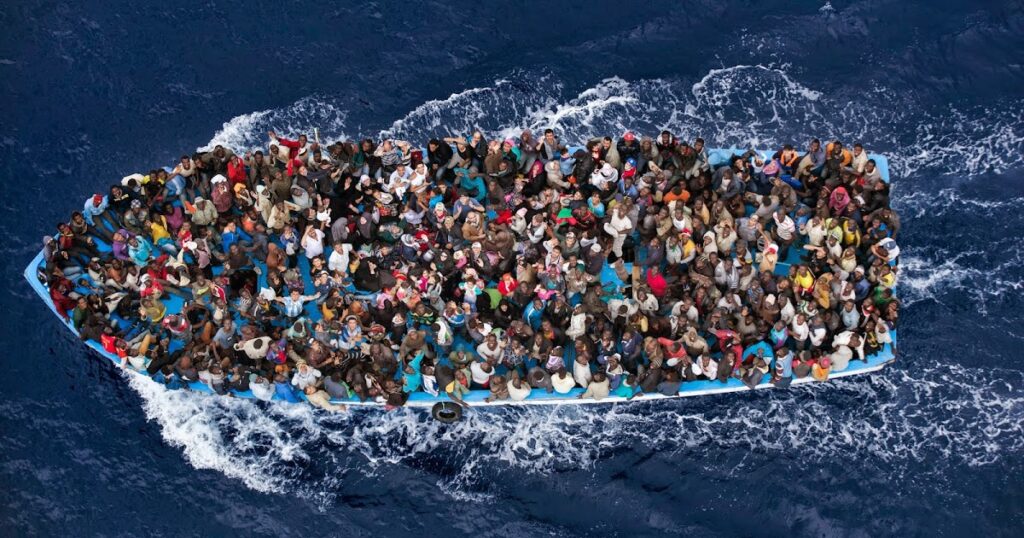
Brief description
With this exercise, we reflect on how perception and representation are shaped by hegemonic frames. We address the way that hegemonic narratives around crisis become naturalized through images. We focus on the 2015 so-called “refugee crisis” and on certain images of people crossing the Aegean Sea on boats. We want the participants to understand that contrary to what these images tells us, the refugee crisis did not just begin with the appearance of certain bodies on the shores of Lesvos, at the doorsteps of Europe it was the outcome of decades of war, devastation and economic stagnation and dependance in several countries, often fueled by European resources and socio-political interests. In this way, we reflect on how images reproduce specific points of view that frame and freeze people and situations in specific spaces and times. What happens if we subtract the term “crisis” from the hegemonic narrative/discourse of what took place in 2015-2016 on the Aegean?
Objectives
- To understand the visual and mediatised discourses of the refugee crisis.
- To critically engage with images that represent the refugee crisis. How are refugees being captured within images of scenes of arrival and frozen in (specific) times and spaces?
- To reflect on what is missing from mainstream images on the refugee crisis and who/what is not being represented.
- To encourage the participants to position themselves in relation to this image. To understand how these images are tied to emergency problem/solution logics.
- What kind of reactions to these images provoke both at the level of governmental policies and at the level of civil society? For example, in the case of the 2015 so-called “refugee crisis” the solutions adopted by many states resulted in stricter border policies, more barbed wire, the proliferation of detention camps, the creation of hotspot islands – and, in general, the implementation of violent politics protecting ‘Fortress Europe’.
- To reflect on the prolifery of images of scenes of refugees’ arrival in contrast to the absence of images that depict refugees’ departure and return. That is, when refugees are forcibly removed/forced to return no one is there to photograph their violent departure, as well as the causes/factors of the forced displacement.

Procedure
Duration: 45 minutes
Step 1
15 minutes
Think of the hegemonic narrative of the refugee crisis, as the appearance of certain bodies on the shores of Europe in the summer of 2015. This narrative was accompanied by many images of boats packed with people approaching the shore.
In groups, looking at the image above, discuss and answer the following questions:
- If you did not have any knowledge of the situation, how would you perceive this image?
- The mainstream narrative speaks of “flows” of migrants and of “waves” of people arriving in Europe. Can you find visual support of these claims in this image?
- From where is the image shot? What perspective do you have as the viewer?
- How would your perception of the phenomenon represented in this image differ if the image was shot from the perspective of someone on this boat?
- What else do you see in this picture?
Step 2
10 minutes
A cruise ship full of tourists approaches the shores of Lesvos after a cruise in the Aegean sea, a very usual sight in summer.
- What is the difference between a ship full of tourists cruising the Aegean sea and the boat represented in this image?
- Whose mobility is framed as irregular, illegal, or criminal, and why?
Step 3
10 minutes
Do you (still) believe that the refugee crisis started with the appearance of these bodies on European soil? Discuss in groups for 10 minutes and try to write down other potential factors that in your view contributed to the so-called “refugee crisis”.
Step 4
10 minutes
Look at the list you came up with and try to think what would be a different way of representing this crisis? Why would such images be important?
Necessary Materials
Expected Results
- To find and look critically at images of the events that took place in 2015-2016.
- To present different ways and methods of representing experiences of seeking refuge and migration and the violence that these experiences entail at the European borders.
- To reflect in a short text on whether it is possible and if so how to represent with images the “non-arrival”, in other words, of what happens to those who do not make it to the European shores. Apart from a written text it can take the form of a poem, drawing, image, short video, song.
- To address the absence of images of departure and to articulate the possible reasons for this and to come up with their own images of departure.
Derived materials from the activity
Images, short texts
Curators + Collaborators during the Test Course:
PAR Athens: Aude Sathoud, Marina Liakis, Marleno Nika, Aila Spathopoulou, Anna Carastathis, Myrto Tsilimpounidi


